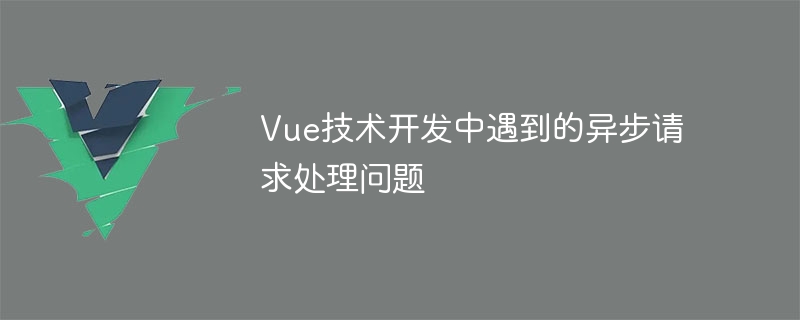

Asynchronous request processing problems encountered in Vue technology development require specific code examples
In Vue technology development, asynchronous request processing is often encountered. Asynchronous requests mean that while sending a request, the program does not wait for the return result and continues to execute subsequent code. When processing asynchronous requests, we need to pay attention to some common issues, such as the order of processing requests, error handling, and concurrent execution in asynchronous requests. This article will combine specific code examples to introduce asynchronous request processing problems encountered in Vue technology development and provide corresponding solutions.
Question 1: The order of processing requests
When making asynchronous requests, sometimes we need to ensure that the requests are executed in order, that is, the second request is sent after the first request returns the result. Below is a sample code that shows how to handle the order of requests.
methods: {
async fetchData() {
try {
const response1 = await axios.get('url1');
// 处理第一个请求的结果
const response2 = await axios.get('url2');
// 处理第二个请求的结果
const response3 = await axios.get('url3');
// 处理第三个请求的结果
// 其他逻辑处理
} catch (error) {
// 错误处理逻辑
}
}
}In the above code, the async and await keywords are used to process asynchronous requests, and the try-catch statement block is used to handle errors. By using the await keyword, you can ensure that the code is executed in order, that is, the second request is sent after the first request returns the result, and so on.
Question 2: Error handling
When processing asynchronous requests, we need to pay attention to error handling. If a request goes wrong, how should we handle this error? Below is a sample code showing how to do error handling.
methods: {
async fetchData() {
try {
const response = await axios.get('url');
// 处理请求的结果
} catch (error) {
// 错误处理逻辑
console.error(error);
}
}
}The above code captures possible errors by using try-catch statement blocks, and outputs error information to the console through the console.error() method. In actual development, we can handle errors according to specific circumstances, such as displaying error prompts to users or performing other operations.
Question 3: Concurrent execution in asynchronous requests
In some cases, we may need to send multiple asynchronous requests at the same time and process them after all requests return results. Below is a sample code that shows how to execute concurrently in asynchronous requests.
methods: {
async fetchData() {
try {
const [response1, response2, response3] = await Promise.all([
axios.get('url1'),
axios.get('url2'),
axios.get('url3')
]);
// 处理所有请求的结果
// 其他逻辑处理
} catch (error) {
// 错误处理逻辑
}
}
}The above code uses the Promise.all() method to send multiple asynchronous requests at the same time, and uses destructuring assignment to obtain the return result of each request. In actual development, we can handle it accordingly according to specific needs.
Through the above code examples and solutions, we can better understand some common problems in handling asynchronous requests in Vue technology development. By mastering the solutions to these problems, we can process asynchronous requests more efficiently and improve our development efficiency. I hope this article is helpful to everyone, thank you!
The above is the detailed content of Asynchronous request processing problems encountered in Vue technology development. For more information, please follow other related articles on the PHP Chinese website!




